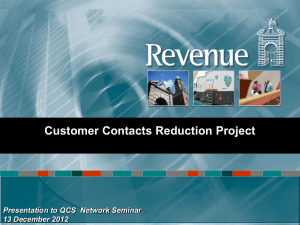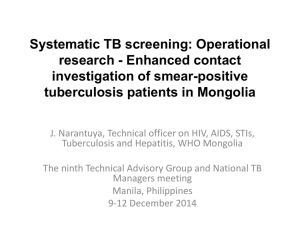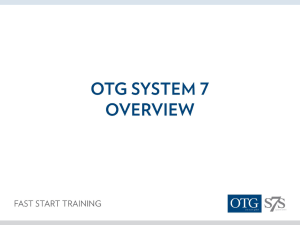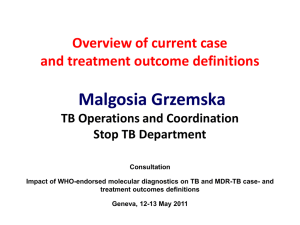Using Existing Data to Improve TB Contact Investigations
advertisement
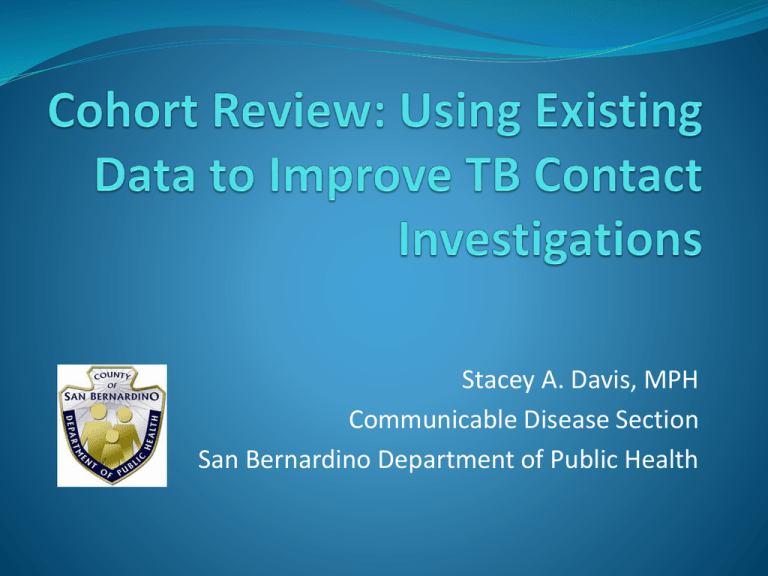
Stacey A. Davis, MPH Communicable Disease Section San Bernardino Department of Public Health Background County San Bernardino County: > 2million people TIP indicator county (>55 cases per year) Largest geographic county in continental US TB Control Program Core Staff 2 RN case managers, 1 FTE communicable disease investigator, 4 health service assistants, 0.7 FTE LVN Public Health Clinic Services: TSTs, CXR, MD follow-up for uninsured patients & contacts; no Quantiferon testing for contacts Questions 1. Are we identifying contacts at highest risk for infection and morbidity? What proportion of contacts complete evaluation, by contact priority level? 2. Can we identify areas for improvement in our contact investigation process? Identification Evaluation Treatment initiation Treatment completion Methods Identify Cohort: Class III (active TB) cases with contact investigations counted in the Q1 and Q2 of 2010, Jan 3 – Jul 3, 2010 Identify Variables Investigation-level variables Contact-level variables 1. High Risk classification (High/Med/Low) * 1) 2) Prolonged or frequent contact with smear + or cavitary CXR TB case or, Exposed to any pulmonary TB case & at high risk for morbidity & mortality (immunocompromised, <5yo, HIV+) Medium 1) 2) Less intense exposure to sm+ case or, Sm - index: Shares house or room w/case, extended contact, aerosol-inducing medical procedure Low Any contact not high or medium priority, limited exposure to index patient Methods Contact-level variables cont’d. 2. Fully evaluated? 3. Reason for missing evaluation 4. Follow-up by PMD or PHD 5. Treatment initiation for LTBI 6. Was contact identified primarily via phone interview or home visit? Data extraction: chart review using data collection tool Data entry: MS Excel Data summary & analysis: MS Excel Results: Cohort description Sputum smear + Smear - , Cx + Other Pulmonary Contact Investigations 18 6 0 # Contacts 260 34 0 HIGH priority 167 6 0 MED priority 88 25 0 LOW priority 5 3 0 0 1* 0 Average contacts per case 14.4 5.7 0 Range contacts per case 2-89 2-13 0 Cases w/ no contacts *1 Contact Investigation: conducted in State Hospital where >200 contacts tested, but DPH had little control over contact identification & evaluation Results: Cohort description Contacts to Smear + Cases (n=260) Medium priority 34% Low priority 2% Contacts to Smear -, Cx + Cases (n=34) Low priority 9% High priority Medium 64% priority 73% High priority 18% Results: Contact Identification Contact Identification (D1): proportion of sputum smear (+) cases with at least one contact identified Smear + Cases Smear -, Cx + Cases 18 of 18 cases=100% 5 of 6 cases=83.3% * *Includes the contact investigation conducted in the State Hospital where 0 contacts were identified and evaluated according to DPH standards Results: Home Visits by Case Type Method of Contact Identification by Case Type Contacts to Smear + cases (n=256) Phone 32% Home visit 68% Contacts to Smear -, Cx + cases (n=34) Home visit 9% Smear + cases (n=18) Smear -, cx + cases (n=6) CDI home visit 12 (66% ) 3 (50%) RN home visit 12 (66%) 4 (66%) Phone 91% Results: Contact Evaluation by Case Type Contact Evaluation (D2): proportion of identified contacts to sputum smear (+) cases who complete evaluation for TB infection or disease Total (n=294) 124 (42.2%) Smear + cases (n=260) 114 (43.9%) Smear – , cx + cases (n=34) 10 (29.4%) Results: Contact Evaluation Rate by Contact Evaluation: Smear + cases (n=260) Priority Level 100% Smear + cases (n=256) ALL 113 (43.8 %) Smear -, Cx + cases (n=34) 10 (29.4%) High priority 84 (50.9%) 3 (50.0%) Medium priority 29 (33.0%) 7 (28.0%) 83 0 (0%) 0 (0%) 5 50% 84 0% Not Evaluated Evaluated 29 0 High Medium Low Contact Evaluation: Smear -, cx + cases (n=34) 100% 80% Low priority 59 3 60% 18 3 40% 20% 0% 3 7 0 High Medium Low Not Evaluated Evaluated Results: Contact Evaluation—Here or There?? Follow-up: Contacts to Smear + cases (n=260) San Bernardino County Contacts to Sm+ Cases: Contact Evaluation Rates (n=220) Not evaluated 55% Evaluated 45% Contacts f/u IJR 14% IJR Contacts to Sm+ Cases: Contact Evaluation Rates (n=36) Contacts f/u in SB County 86% Not evaluated 64% Evaluated 36% Results: Contact Evaluation—Here San Bernardino County Contacts to or There?? Sm - Cases: Contact Evaluation Rates (n=33) Follow-up: Contacts to Smear -, Cx + Cases Contacts f/u OOJ 3% Contacts f/u in SB County 97% Evaluated 30% Not evaluated 70% IJR contacts to Sm – Cases: 0 of 1 contacts completed evaluation Results: Type of Medical Evaluation Type of Medical Evaluation: Contacts to Smear + Cases Followed by Both PMD & PHD 9% Unknown 0% Followed by PMD 14% Followed by PHD 77% Type of Medical Evaluation: Contacts to Smear -, Cx + Cases Followed by Both PMD & PHD 0% Followed by PHD 47% Unknown 0% Followed by PMD 53% Results: Evaluation Outcome by Case Type Smear + (n=256) Smear -, cx + (n=34) Evaluation Complete 113 (43.5%) 10 (29.4%) TB Disease 1 (0.9%) 0 (0.0%) Latent TB Infection 35 (31.0%) 2 (20.0%) Not infected 77 (68.1%) 8 (80.0%) Not Evaluated/Disease Status Unknown 143 (55.9%) 24 (70.6%) Results: Why were contacts not completely evaluated? Reasons Not Evaluated: Contacts to Smear + Cases (n=146, 56.5%) IJR 15% Doc UTC Refused 5% 6% Reasons Not Evaluated: Contacts to Smear -, Cx + Cases (n=24, 70.6%) IJR Doc UTC 4% 4% PMD 0% LTFU 74% Refused 13% PMD 0% LTFU 79% Results: Treatment Initiation & Completion Contact Treatment Initiation (D3): proportion of infected contacts to pulmonary cases started on treatment for LTBI Contact Treatment Completion (D4): proportion of contacts w/ LTBI completed treatment Reasons Treatment Not Completed: Contacts to Smear + Cases (n=16, 59.3%) Contacts to Smear + Cases (n=35) Contacts to Smear -, cx + Cases (n=2) Treatment Initiation Rate (D3) 27 (77.1%) 1 (50.0%) Treatment Completion Rate (D4) Incomplete data 0 (0.0%) Contact Adverse Effect Active TB Moved (followProvider of Medicine Developed up unknown) Decision 0% 0% 0% 0% Death 0% Unknown 6% Contact Chose to Stop 6% Contact is Lost to Follow-up 19% Still on Treatment 69% Conclusions 1. Contact Identification (D1) Identify ≥1 contact per case Could we increase % investigations with at least one home visit? Conclusions 2. Contact Evaluation (D2) a) By contact priority level b) By case type c) Majority of contacts are lost to follow-up Local vs. IJR follow-up e) Below CA average rate for contacts evaluated (44%, 29%, respectively) Reasons for incomplete follow-up d) High priority contacts to both types of index cases: ~50% evaluated Medium priority contacts to both types of index cases: ~30% evaluated Only 14%, 3%, respectively, followed out of jurisdiction Types of medical evaluation (PMD vs. PHD) 53% of contact to smear -, cx + cases were followed by PMD do we need to establish better tracking mechanisms or relationships to follow evaluation? Conclusions 5. Contact Treatment Initiation (D3) Can improve treatment initiation by complete medical evaluation 6. Contact Treatment Completion (D4) How can we eliminate the LTFU (19%, contacts to smear + cases) Next Steps Update action plan for contact investigation indicator improvements Reconvene focus group on contact investigation protocol Examine complete evaluation by home visit status Regular cohort review Regularly conduct cohort reviews using established tools & baseline Regularly assess contact prioritization & investigation strategies Regularly track progress of our contact investigations

